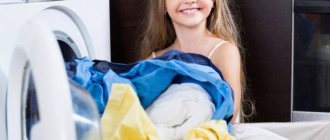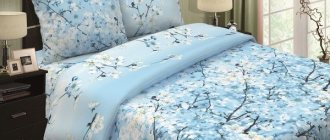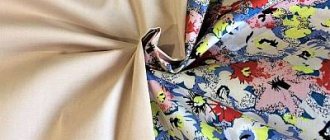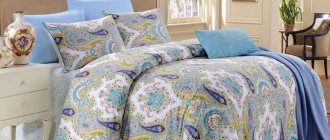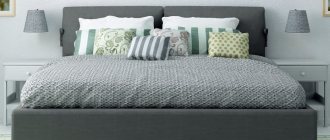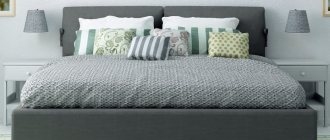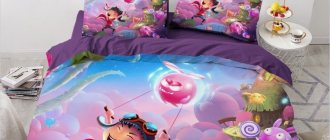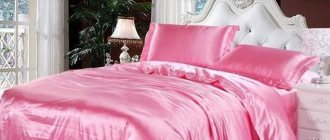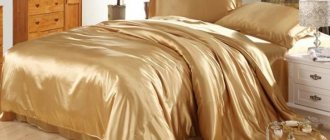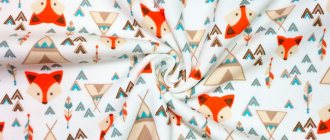Percale - pros and cons
Indian masters were the first to learn how to weave the material, and in Europe it appeared in the royal bedrooms of the 18th century. Since its creation, it has belonged to the luxury category and is associated with exquisite taste and chic.
The privileged position is explained by the properties of long-staple cotton of Egyptian origin, which serves as the raw material for production. Percale has a thin, delicate and smooth structure, at the same time dense and durable. Its surface is slightly cool and can soothe skin heated by the heat.
The material is easy to wash, does not require special care and is designed for long-term use. Its only drawback is that it wrinkles, and to deal with creases you will need to spend time and use a steamer.
Cotton fabric with a silky surface is similar in appearance to cambric.
Interesting fact!
Percale does not have the most pleasant meaning in the original language - rag.
How to distinguish percale from calico?
Let's start with the fact that both percale and calico are made by simple plain weave of threads.
In the process of making calico, threads of the same thickness are used. The technology for making percale is somewhat different - the front threads are thin, treated with a special adhesive, and the back threads are thick.
You can distinguish calico from percale by touch - percale is smoother, silkier and more delicate. Calico is more loose. External differences are also noticeable to the naked eye - percale is characterized by a beautiful semi-matte shine, while calico looks more simple and prosaic.
The differences between satin and percale are less pronounced - both fabrics have a smooth and silky top layer, while percale is rougher and denser than satin.
Poplin - description
The fabric has a plain weave and a relief with a characteristic small rib. The technology was developed in France many centuries ago, and the canvas was intended for the clothes of the Pope. The structure is obtained through the use of threads of different thicknesses. The base is formed from thin fibers that are intertwined with thicker ones.
Poplin has good tactile properties, it is pleasant and soft. It has the density and strength of fabrics for sewing overalls.
Modern textiles are produced:
- bleached;
- variegated;
- printed;
- plain painted.
Poplin is produced in different colors and is used mainly for bed linen. Pajamas, men's shirts, dresses and other everyday clothes are also made from this fabric. The sets are comfortable to use and are durable in shape and color. The positive properties of poplin include the ability to retain heat, absorb moisture and allow air to pass through.
General characteristics of satin, poplin and calico
We suggest starting the answer to the question of which bedding is better, satin, calico or poplin, with the characteristics common to each of the listed types of fabric.
All of them are made from cotton. Natural material gives products general characteristics:
- good breathability – fabrics allow air to pass through and allow the body to “breathe”;
- hygroscopicity – maintain a comfortable body temperature, absorb excess moisture;
- ability to retain heat - cotton, unlike silk, warms, you can sleep under such sheets at any time of the year;
- wear resistance - calico, percale and satin have a good margin of strength, do not require special care, can be machine washed without requiring delicate cycles, can withstand up to 150-200 washes without visible deformations and changes in brightness and color;
- hypoallergenic, environmentally friendly - do not cause allergic reactions, are used for sewing children's clothing;
- practicality - bed linen is easy to iron, does not shrink or change shape after washing, and rarely fades.
When you buy a set of cotton underwear, you can't go wrong because you're getting quality created by nature.
What is better for bed linen
The quality of bed linen has a direct connection with proper rest and healthy sleep. Therefore, the choice of material must be conscious, taking into account the advantages and disadvantages.
It remains to evaluate whether percale or poplin is better and for what conditions.
Both materials are made from cotton raw materials using plain weave technology. The structure resembles a checkerboard pattern, where the warp thread is replaced by weft, overlapping one another. This is the similarity between them.
Now about the differences:
- Percale fibers are much thinner than poplin. In addition, they are carefully combed out and covered with an adhesive composition without twisting. These factors give it maximum strength. It’s not for nothing that the material is used in sewing parachutes and finishing airplane wings.
- If you examine fabric samples against the light, you will find that the structure of poplin is looser, while that of percale is denser. This is explained by the tightness of the mutual fit of the threads during manufacturing. Our grandmothers used percale covers for pillows and featherbeds, knowing the property of the material to reliably retain down and feathers.
Advice!
Manufacturers reserve the right to add synthetic fibers that affect properties. Be sure to look at the label before purchasing.
- Percale is a leader in density and strength, which ensure wear resistance and durability. It has higher quality indicators and a service life of 10 years, while poplin underwear is designed for 5.
- In terms of physical characteristics, both fabrics are thin and light. The poplin is soft to the touch and does not wrinkle. Percale is silky and cool, which is important for summer days. However, it wrinkles and requires ironing after washing.
- Percale has a reverse side, noticeable to the touch and in color saturation, and poplin is a double-sided material. Percale bed linen has a number of other advantages:
- Withstands about 100 washes without loss of properties;
- Perfectly comfortable fabric that warms and cools;
- High density and strength;
- There is no shrinkage after washing and no unsightly pilling.
Several facts in favor of poplin.
- Air permeability and heat-saving properties.
- Resistance to crushing and deformation, which makes the work of housewives easier.
- Smoothness, softness and comfort while sleeping.
- Care is limited to normal washing.
However, the fabrics are not inferior to each other in appearance. They delight with bright colors and beautiful patterns. Both materials are easy to cut and sew, do not slip or warp. With similar qualities, a poplin set will cost less.
Expert opinion
Alyona
Fabric expert and technologist Alena Khlebnikova is ready to answer your questions.
Write to us
There is no universal answer to which is better. This is a matter of personal preference and material capabilities.
Interesting fact
European manufacturers have rated percale bed linen sets at the level of satin products.
Comparison of technical characteristics and properties of fabrics
Analysis of the technical characteristics of each type of material allows you, based on your desires, to choose the material that best suits your preferences. Below is a description of common cotton textile options.
Calico
This is one of the most famous types of fabric for bed linen. The material is a plain weave with a relative density (up to 160 g/m²), which provides it with strength and durability. For the manufacture of bed linen, two types of calico are used: bleached or plain-dyed.
Calico fabric
Note! For public institutions, more durable but rough material is used. For household purposes, calico bed linen is made with thin and durable fibers woven into it; this is the highest quality and most expensive luxury option.
- "Ranfors" is one of several variations of calico, which is more reminiscent of poplin.
- “Standard”, “Comfort”, “Light” are fabrics with varying degrees of density (from 125-110 g/m²), differing in the softness and smoothness of the outer layer. All options have sufficient strength and almost imperceptible shrinkage.
The finer and denser the weave of the threads, the higher the quality. As a result, the cost of the canvas also increases.
Weaving calico
Bedding sets made from calico are affordable and practical. When choosing between percale or calico, it is worth noting that calico also does not fade, absorbs moisture, does not fade and retains heat well. The resistance of this material to bacteria makes it possible to use it for sewing linen for cribs.
The disadvantages include some roughness and looseness of the fabric, visible compactions in the threads, which create a feeling of roughness. Calico wrinkles a lot, and if it contains synthetic fibers, it can pill.
Percale
Percale is often confused with poplin due to its external similarity. The fabric is made from high-quality cotton fibers using plain weave. To avoid pilling, the fibers are treated with a special compound, resulting in a smooth and silky fabric.
Percale weave
The material is wear-resistant and can withstand up to 1000 washes. It easily removes dirt even at low temperatures. When choosing which is better - percale or calico, it is worth remembering that the thread density of the first is higher.
Important! After repeated washings, the fabric does not lose its appearance and remains soft. Since the material is difficult to iron, experts recommend adding conditioner to the water during the rinsing procedure.
You might be interested in this Description of all varieties of Slavic fabrics
If you compare which is better for bed linen - percale or satin, then you should take into account the greater durability of products made from percale.
Percale after washing
Poplin
This material is a worthy competitor to percale or calico with a dense structure in terms of practicality, and in terms of softness - satin. According to the type of dyeing, the material can be plain-dyed, bleached, printed or multi-colored.
A special feature of production is the use of threads of different thicknesses. The base consists of thin fibers, thicker ones are passed through it. This weaving allows you to create a thin and at the same time tear-resistant fabric.
Poplin weave
Most often pajamas, nightgowns, and children's clothes are made from poplin. When comparing which is better - percale or poplin, it is worth noting the unpretentiousness and ease of care of both fabrics. The main advantage is that even after 200 washes the product retains its shape. The cost of a set of poplin linen is almost the same as that of calico, but it is softer and more beautiful.
Important! Poplin is cheaper than percale. But its service life is significantly shorter.
Satin
If the main selection criterion is the softness and delicacy of the fabric, then, of course, you should give preference to satin. It contains 100% high quality natural cotton. The method of weaving threads is called satin or satin.
Satin weave
In the finished fabric, weft threads predominate on the surface, creating a diagonal scar. Satin with a density from 80 to 130 g/m² is available on sale. After mercerization (treatment with sodium hydroxide), the fabric acquires even greater strength and color fastness.
Note! Glossy shine is present only on the front side, on the back the canvas is matte with a slight roughness. It is this characteristic that prevents the sheet from sliding off the bed.
The difference between satin bed linen: it absorbs moisture well, retains heat, and removes static electricity. Products made from this material are designed for long-term use - up to 8 years. Satin is the most expensive type of cotton textile.
Satin for bed linen
Care
Cotton fabrics have the same care rules.
- Follow label recommendations.
- Wash products made from natural fibers separately from other types of fabrics.
- The water temperature should not exceed 60°.
- To dry, laundry can be hung and laid out on a horizontal surface.
- The materials are not afraid of sunlight and temperature exposure. It is allowed to use fan heaters and leave them outside on a hot day.
- Iron with the iron heated to 150°.
- The storage cabinet and laundry basket must have ventilation.
Caring for poplin and percale bed linen
Both bed linen are very unpretentious in use. The only caveat is that percale linen requires more careful ironing. Otherwise, poplin or percale bedding remains equally comfortable and suitable. Bed linen will easily last five years or more if you follow simple requirements:
- Before washing, store laundry in a basket with holes where air can penetrate,
- wash at 60 degrees (no more than 80),
- You can dry your clothes in the air, even if the sun is shining,
- It is better to iron only from the inside out at a temperature of no more than 150 degrees.
